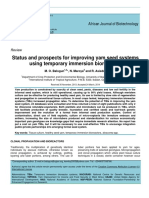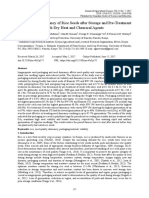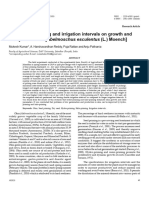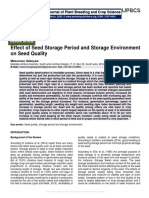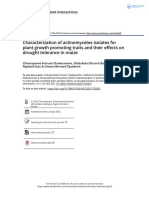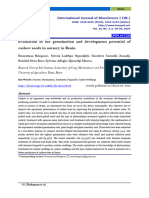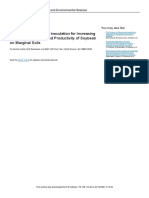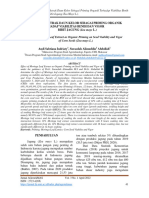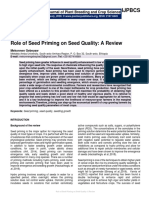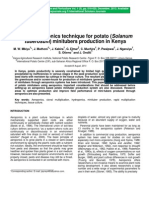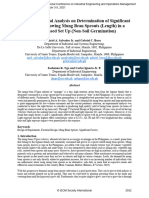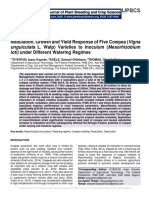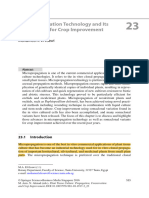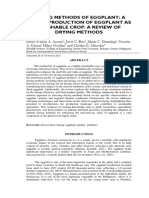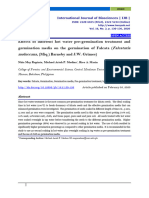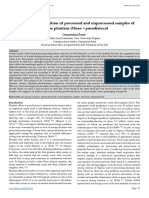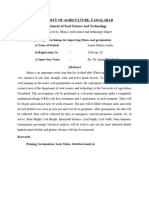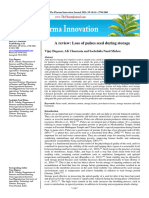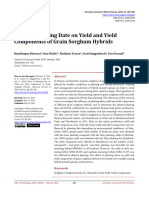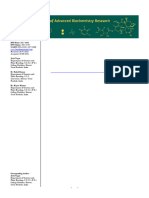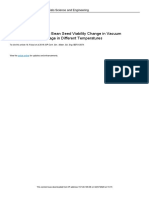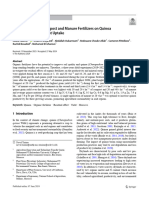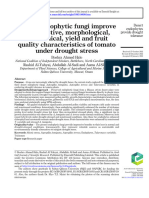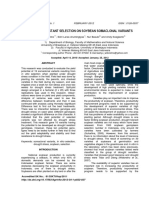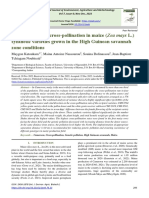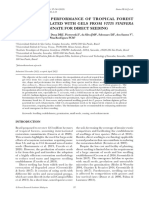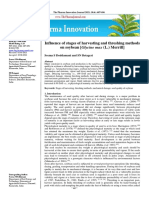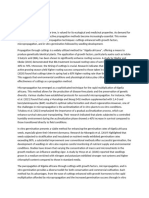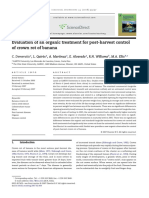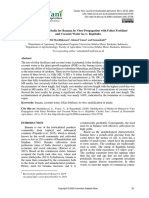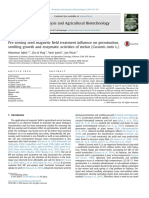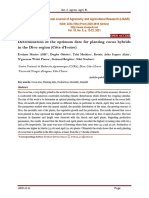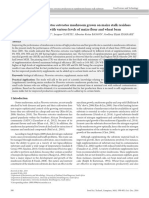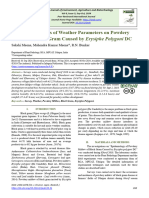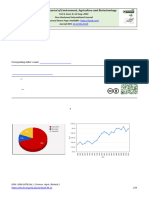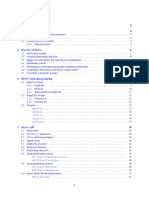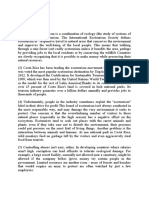Impact of Maize Seed Moisture Content Reduction On Germination Parameters As Influenced by Sun Drying
Impact of Maize Seed Moisture Content Reduction On Germination Parameters As Influenced by Sun Drying
Uploaded by
Mamta AgarwalCopyright:
Available Formats
Impact of Maize Seed Moisture Content Reduction On Germination Parameters As Influenced by Sun Drying
Impact of Maize Seed Moisture Content Reduction On Germination Parameters As Influenced by Sun Drying
Uploaded by
Mamta AgarwalOriginal Title
Copyright
Available Formats
Share this document
Did you find this document useful?
Is this content inappropriate?
Copyright:
Available Formats
Impact of Maize Seed Moisture Content Reduction On Germination Parameters As Influenced by Sun Drying
Impact of Maize Seed Moisture Content Reduction On Germination Parameters As Influenced by Sun Drying
Uploaded by
Mamta AgarwalCopyright:
Available Formats
International Journal of Environment, Agriculture and Biotechnology
Vol-8, Issue-4; Jul-Aug, 2023
Peer-Reviewed International Journal
Journal Home Page Available: https://ijeab.com/
Journal DOI: 10.22161/ijeab
Impact of Maize Seed Moisture Content Reduction on
Germination Parameters as Influenced by Sun Drying
T. M. Awopegba1,* and Augustine A. Matthew2
1Departmentof Agricultural Technology, Ekiti State Polytechnic, Isan-Ekiti, Nigeria
2Departmentof Crop, Soil and Pest Management, University of Africa, Toru-Orua, Bayelsa State, Nigeria
*Corresponding Author Email: awopegbatolulope@gmail.com
Received: 17 Jun 2023; Received in revised form: 13 Jul 2023; Accepted: 19 Jul 2023; Available online: 27 Jul 2023
©2023 The Author(s). Published by Infogain Publication. This is an open access article under the CC BY license
(https://creativecommons.org/licenses/by/4.0/).
Abstract— When growing seedlings for commercial purposes, excellent seed quality is crucial. Seed
quality influences germination rate because seeds that sprout slower typically produce lower-quality
seedlings. In numerous plants, seed moisture content has a significant impact on seed germinating speed.
This study investigates the impact of various moisture content (MC) reductions on maize germination
parameters and determines the moisture content level essential for maize germination. A comprehensive
laboratory experiment was laid out in a completely randomized design (CRD) consisting of five treatments
and three replicates. The treatment levels were maize seeds not sun-dried after collection (control), maize
seed sun-dried for 3 days, maize seed sun-dried for 6 days, maize seed sun-dried for 9 days, and maize seed
sun-dried for 12 days. Data were obtained on shoot length, root length, seedling length, germination
percentage (GP), germination energy (GE), mean germination time (MGT), and seedling vigour index
(SVI). All germination parameters were taken and calculated and the experiment was terminated two
weeks after planting (WAP). Results indicated that the control significantly (p<0.05) performed better than
other treatments for all the germination parameters. It was determined that maize with moisture content of
9.4% and below had low germination ability. This study concludes that the impacts of reduced moisture
content on maize's physical properties (quality, texture, shape), chemical composition (fat and starch
content), and biological characteristics (seed viability) resulted in the low germination ability of maize
seeds.
Keywords— Germination parameters, maize seed, moisture content reduction, sun drying.
I. INTRODUCTION For operations including the production, selling, and
Maize, commonly referred to as corn is widely grown processing of maize (Zea mays L.), as well as serving as
around the world (Awopegba et al., 2017; Suleiman et al., the basis for research, grain moisture content (GMC)
2013). Maize is a member of the grass family measurement precision is crucial (Gao et al., 2021). A key
(family: Poaceae, previously Gramineae) (Badu-Apraku element in maintaining resistant seeds quality is moisture
and Fakorede, 2017). Globally, maize grain is an important content. The odd association of subcellular water with
source of food, feed, and raw materials for industrial macromolecular surfaces in seeds ensures membrane and
processes. Starch, protein, oil, and fiber, which make up macromolecule preservation (Patil and Krishna, 2016).
around 95% of the biomass of harvested grains, are the The loss of water during the drying process results in
main nutritious components (Bheemanahalli et al., 2022; several metabolic changes that affect the control of growth
Venkatesh et al, 2016). Maize is a staple grain crop grown regulators, the quantity and type of proteins and
in temperate and tropical locations across the globe in a carbohydrates, the presence of free radicals, and the
variety of soil types and climates (Khaeim et al., 2022). physical water status, among other things, and causes the
deterioration process to begin. When the germination
ISSN: 2456-1878 (Int. J. Environ. Agric. Biotech.)
https://dx.doi.org/10.22161/ijeab.84.6 46
Awopegba and Matthew International Journal of Environment, Agriculture and Biotechnology, 8(4)-2023
percentage was significantly reduced, this moisture was overlapping extrinsic and abiotic stimuli impacts
called critical moisture content. When there was no propagation success (Norgrove, 2021).
germination, it was called fatal moisture content (Patil and Maize is traditionally dried outside in the sun. To dry
Krishna, 2016). maize, lay the grains out on a mat and expose them to the
Maize deformation results from high moisture content in sun (Ntwali et al., 2021). Sun drying is an alternative and
storage. Maize is dried for planting in a variety of affordable method for smallholder farmers of reducing
traditional ways, including sun, hot air, and other methods. maize moisture content (Kaminski and Christiaensen,
In addition, maize seeds are damaged when dried at high 2014). Uneven moisture removal, exposure to insects,
temperatures (Nair et al., 2011). Drying seeds artificially rodents, birds, and dust, and failure to obtain an acceptable
requires removing extra moisture. Seed drying lowers moisture level due to a significant dependence on weather
respiration while also preventing seed quality from conditions are the method's drawbacks for sun-drying
deteriorating in storage due to microbial development and (Fudholi et al., 2010). However, this study investigates the
insect and mite activity (El-Abady, 2014). Maize seeds impact of various moisture content (MC) reductions on
lose moisture during drying, causing physical changes. maize germination parameters and determines the level of
Changes in mass, volume, density, colour, and porosity are moisture content essential for maize germination.
typically used to characterize physical changes in
cereal grains during growth or a decrease in moisture
II. MATERIALS AND METHODS
content (Cârlescu et al., 2023). However, moisture-rich
maize should not be stored. Experimental Site
Germination is the process through which a seed or spore A comprehensive laboratory experiment was conducted in
grows into a plant following a period of inactivity (Wade the Agricultural Technology Department of Ekiti State
et al., 2016). Seed germination is a protrusion of the Polytechnic, Isan Ekiti. It is located in the rainforest
radicle from the tissue(s) enclosing it (Soltani et al., 2015). agroecological zone in southwest Nigeria. The laboratory
A seedling grows and develops during germination, a has a constant 220C temperature. The experiment was
physiological process that sets off a chain reaction of carried out between January 12th and February 7th, 2023.
biological and biochemical events (Khaeim et al., 2022; Source of Material
Poudel et al., 2019). Rapid water absorption by seeds
Improved maize variety (Mastrop 143) was collected from
during the imbibition phase of germination causes the seed
Sunbeth Global Concepts, Ondo State, Nigeria.
coat to stretch and soften at the right temperature (Fu et
al., 2021). The seed's internal physiological processes are Experimental Design
then triggered, and respiration begins (Itroutwar et al., This study consists of five (5) treatments. Ten (10) seeds
2020; Koornneef et al., 2002). Last but not least, the were planted per replicate which makes it thirty (30) seeds
cracked seed coatings enable the development of radicles per treatment as each treatment was replicated three times.
and plumules. This means that, as a result, it begins with In this study, the experimental design was completely
the dry, dormant seed absorbing water and ends with the randomized (CRD). The treatment levels were:
radicle emerging as a result of the lengthening of the
T1 = Maize seed not sun-dried after collection (Control)
embryo axis (Fu et al., 2021). Several coordinated
physiological and morphogenetic processes, such as seed T2 = Maize seed sun-dried for 3 days
energy transfer, endospermic nutrition absorption, and T3 = Maize seed sun-dried for 6 days
physiological and metabolic changes are all involved in T4 = Maize seed sun-dried for 9 days
this process (Nciizah et al., 2020).
T5 = Maize seed sun-dried for 12 days
Germination impacts maize yield and quality (Xue et al.,
2021). Plants develop fundamentally from a single seed For all the sun-dried maize, it was sun-dried for 7 hours
into a plant (Lara-Núñez et al., 2021). The interaction of between 9:00 am and 4:00 pm daily.
environmental variables and seed physiological conditions Planting and Cultural Practices
regulates germination (McCormick et al., 2016). Desiccators were used to store maize seeds not to absorb
Germination is influenced by temperature, light, and water moisture after sun drying. Maize seed was uniformly
availability (McCormick et al., 2016). Seed germination planted at 3 cm depth. Maize seeds were planted directly
reflects population size, distribution, and abundance in moisture containers containing sterilized loam soil and
(Khaeim et al., 2022). Seed physiological response to arranged on the slab in the Agricultural Technology
Laboratory. A maize seed was planted inside each
ISSN: 2456-1878 (Int. J. Environ. Agric. Biotech.)
https://dx.doi.org/10.22161/ijeab.84.6 47
Awopegba and Matthew International Journal of Environment, Agriculture and Biotechnology, 8(4)-2023
moisture container and water was applied every day. All the longer the sun-drying duration, the lower the moisture
germination parameters were taken and calculated and the content of maize seeds.
experiment was terminated two weeks after planting Table 1: Moisture Content of Maize Influenced by Sun
(WAP). Drying
Data Collections Treatments Moisture
Immediately after the collection of maize seeds, the Content (%)
moisture content was determined with a moisture meter
T1= Control (Maize not sun-dried after 14.6
before planting. The moisture content at every stage of
collection)
planting was also determined with a moisture meter.
Germination parameters were taken every 24 hours up to T2= Maize sun-dried
two weeks after planting. Data were obtained on plant for 3 days 12.0
shoot length (plumule), plant root length (radicle), seedling T3= Maize sun-dried for 6 days 9.4
length, germination percentage (GP), germination energy T4= Maize sun-dried for 9 days 6.9
(GE), mean germination time (MGT), and seedling vigour
T5= Maize sun-dried for 12 days 5.2
index (SVI).
• Plant shoot length was determined using measuring
tape in centimetres. Plant root length was determined Table 2 shows the impact of moisture content reduction on
with a measuring tape after uprooting the plant. The maize shoot and seedling length as influenced by sun
seedling length was obtained by combining plant drying. There were significant differences among the
shoot length and plant root length. treatments in root length. T1 had the longest root length
while T5 had the least. Significant differences in shoot and
seedling length occurred among the treatments. T1 had the
longest shoot and seedling length and the shortest was T5.
Table 2: Impact of Moisture Content Reduction on Maize
Shoot and Seedling Length as Influenced by Sun Drying
where n = Number of seeds germinated on each day, d = Treatments Root length Shoot length Seedling
Number of days from the beginning of the test, and (cm) (cm) length (cm)
N = Total number of seeds germinated at the termination T1 8.28a 7.22a 15.50a
of the experiment.
T2 7.70b 6.70b 14.40b
• SVI = Seedling Length × Germination Percentage
(Anupama et al., 2014) (4) T3 7.25c 6.16c 13.41c
Data Analysis T4 7.00cd 5.50d 12.50d
The data obtained on the germination parameters were T5 6.00e 4.45e 10.45e
analyzed statistically using Analysis of Variance. Data * Means followed by the same letter in the same column
were examined with SPSS version 21 and Duncan's are not significantly (p> 0.05) different as indicated by
Multiple Range Test (DMRT) was used to compare Duncan Multiple Range Test.
treatment means.
Table 3 shows the impact of moisture content reduction on
III. RESULTS AND DISCUSSION germination parameters as influenced by sun drying.
Table 1 shows the moisture content of maize seeds Germination parameters under consideration were
influenced by sun drying. The moisture content of maize germination percentage, germination energy, and seedling
sun-dried for 3 days (T2), maize sun-dried for 6 days (T3), vigour index. Significantly, higher seed germination
maize sun-dried for 9 days (T4), and maize sun-dried for (93.33 percent) was observed in seeds planted immediately
12 days (T5) were 12.0%, 9.4%, 6.9%, and 5.2% after collection (T1). In addition, the maize seeds sun-dried
respectively while the moisture content of the control was for 3 days (T2) performed relatively well compared with
14.6%. Patil and Krishna (2016) discovered that a the control in terms of germination percentage. The lowest
reduction in the moisture content of seeds occurs during seed germination (13.33 percent) was observed in seeds
drying under shade and that the longer the time of drying sun-dried for 12 days (T5). In general, seeds' moisture
the more the reduction of moisture content. In other words, content dropped as drying time increased, inhibiting seed
ISSN: 2456-1878 (Int. J. Environ. Agric. Biotech.)
https://dx.doi.org/10.22161/ijeab.84.6 48
Awopegba and Matthew International Journal of Environment, Agriculture and Biotechnology, 8(4)-2023
germination. Broschat and Donselman’s (1986) findings in IV. CONCLUSION
the tropical species corroborated this study. As for the This study demonstrated that reducing maize moisture
germination energy, the data were taken 6 days after content below 12% affects germination of maize.
planting. There were significant differences among the Germination percentage varied between 93.33% and
treatments. Significantly, T1 germinated faster than every 83.33% when the moisture content was 14.6% and 12%.
other treatment while the least was recorded for T 5. The Below that, 46.67% was obtained as a germination
highest seedling vigour was observed for T 1, while it percentage for maize at 9.4% moisture content. Other
declined as maize moisture content reduced across other germination parameters such; as germination energy,
treatments. seedling vigour index, and mean germination time were
Table 3: Impact of Moisture Content Reduction on also considered. It was determined that maize with 9.4%
Germination Parameters as Influenced by Sun Drying moisture content had low germination ability. This study
Treatments GP (%) GE (%) SVI concludes that the impacts of reduced moisture content on
maize's physical properties (quality, texture, shape),
T1 93.33a 90.00a 1446.62a chemical composition (fat and starch content), and
T2 83.33ab 53.33b 1199.95b biological characteristics (seed viability) resulted in maize
T3 46.67c 40.00c 625.84c seeds' low germination ability.
T4 26.67d 23.33d 333.38d
T5 13.33e 6.6e 139.30e REFERENCES
[1] Anupama, N., Murali, M., Sudisha J. and Amruthesh, K. N.
*Means followed by the same letter in the same column
(2014). Crude oligosaccharides from alternaria solani with
are not significantly (p> 0.05) different as indicated by
bacillus subtilis enhance defense activity and induce
Duncan Multiple Range Test. resistance against early blight disease of tomato. Asian
Journal of Science and Technology, 5(7), 412-416.
[2] Awopegba, M., Oladele, S. and Awodun, M. (2017). Effect
Figure 1 shows the mean germination time influenced by
of mulch types on nutrient composition, maize (Zea mays
sun-drying maize seeds. Reduction in maize seeds' L.) yield and soil properties of a tropical Alfisol in
moisture content caused an increase in germination time. Southwestern Nigeria. Eurasian Journal of Soil
There was an increase in the mean germination time as the Science, 6(2), 121-133.
moisture content decreased. T1 with the highest moisture [3] Badu-Apraku, B. and Fakorede, M. A. B. (2017).
content has the lowest mean germination time compared to Morphology and Physiology of Maize. Advances in genetic
other treatments, which makes it better than the rest of the enhancement of early and extra-early maize for sub-
treatments. The fastest germination has the lowest mean Saharan Africa, 33-53.
[4] [4] Bheemanahalli, R., Ramamoorthy, P., Poudel, S.,
germination time. Fetouh and Hassan (2014) established
Samiappan, S., Wijewardane, N. and Reddy, K. R. (2022).
that faster germination leads to lower values of the speed
Effects of drought and heat stresses during reproductive
index known as mean germination time (MGT). Reduction stage on pollen germination, yield, and leaf reflectance
in moisture content seriously affected T4 and T5. properties in maize (Zea mays L.). Plant Direct, 6(8),
e434.
10 8.4
7.5 [5] Broschat, T. K. and Donselman, H. (1986). Factors affecting
Mean Germination
8 6.5 storage and germination of Chysalidocarpus lutescens seeds.
5.8
Time (Days)
5.1 Journal of the American Society for Horticultural
6 Science, 111(6), 872-877.
4 [6] Cârlescu, P. M., Băetu, M. M., Roșca, R. and Țenu, I.
(2023). Studies on the Physical Changes in Corn Seeds
2 during Hybrid Drying (Convection and Microwave).
0 Agriculture, 13 (3), 519.
T1 T2 T3 T4 T5 [7] El-Abady, M. I. (2014). Viability of stored maize seed
exposed to different periods of high temperature during the
Treatments artificial drying. Research Journal of Seed Science, 7(3), 75-
86.
Fig. 1: Mean Germination Time Influenced by Sun Drying [8] Fetouh, M. I. and Hassan, F. A. (2014). Seed germination
criteria and seedling characteristics of Magnolia grandiflora
Maize Seeds
L. trees after cold stratification treatments. International
Journal of Current Microbiology and Applied
Sciences, 3(3), 235-241.
ISSN: 2456-1878 (Int. J. Environ. Agric. Biotech.)
https://dx.doi.org/10.22161/ijeab.84.6 49
Awopegba and Matthew International Journal of Environment, Agriculture and Biotechnology, 8(4)-2023
[9] Fu, F. F., Peng, Y. S., Wang, G. B., El-Kassaby, Y. A. and [23] Ozden, E., Light, M. E. and Demir, I. (2021). Alternating
Cao, F. L. (2021). Integrative analysis of the metabolome temperatures increase germination and emergence in
and transcriptome reveals seed germination mechanism in relation to endogenous hormones and enzyme activities in
Punica granatum L. Journal of Integrative aubergine seeds. South African Journal of Botany, 139, 130-
Agriculture, 20(1), 132-146. 139.
[10] Fudholi, A., Sopian, K., Ruslan, M. H., Alghoul, M. A. and [24] Patil, S. S. and Krishna, A. (2016). Influence of seed
Sulaiman, M. Y. (2010). Review of solar dryers for moisture content on seed germination and quality in canes.
agricultural and marine products. Renewable and Journal of Plant Science and Research, 3(2), 156.
sustainable energy reviews, 14(1), 1-30. [25] Poudel, R., Finnie, S. and Rose, D. J. (2019). Effects of
[11] Gao, S., Ming, B., Li, L. L., Xie, R. Z., Wang, K. R. and Li, wheat kernel germination time and drying temperature on
S. K. (2021). Maize grain moisture content correction: From compositional and end-use properties of the resulting
nonstandard to standard system. Biosystems whole wheat flour. Journal of Cereal Science, 86, 33-40.
Engineering, 204, 212-222. [26] Soltani, E., Ghaderi-Far, F., Baskin, C. C. and Baskin, J. M.
[12] Itroutwar, P. D., Kasivelu, G., Raguraman, V., Malaichamy, (2015). Problems with using mean germination time to
K. and Sevathapandian, S. K. (2020). Effects of biogenic calculate rate of seed germination. Australian Journal of
zinc oxide nanoparticles on seed germination and seedling Botany, 63(8), 631-635.
vigor of maize (Zea mays). Biocatalysis and Agricultural [27] Suleiman, R., Rosentrater, K. A., & Bern, C. (2013). Effects
Biotechnology, 29, 101778. of deterioration parameters on storage of maize: A
[13] Kaminski, J. and Christiaensen, L. (2014). Post-harvest loss review. Journal of Natural Sciences Research, 3(9), 147-
in sub-Saharan Africa—what do farmers say?. Global Food 165.
Security, 3(3-4), 149-158. [28] Venkatesh, T. V., Chassy, A. W., Fiehn, O., Flint-Garcia, S.,
[14] Khaeim, H., Kende, Z., Jolánkai, M., Kovács, G. P., Zeng, Q., Skogerson, K. and Harrigan, G. G. (2016).
Gyuricza, C. And Tarnawa, Á. (2022). Impact of Metabolomic assessment of key maize resources: GC-MS
temperature and water on seed germination and seedling and NMR profiling of grain from B73 hybrids of the nested
growth of maize (Zea mays L.). Agronomy, 12(2), 397. association mapping (NAM) founders and of geographically
[15] Koornneef, M., Bentsink, L. and Hilhorst, H. (2002). Seed diverse landraces. Journal of Agricultural and Food
dormancy and germination. Current opinion in plant Chemistry, 64(10), 2162-2172.
biology, 5(1), 33-36. [29] Wade, E. M., Nadarajan, J., Yang, X., Ballesteros, D., Sun,
[16] Kulkarni, M. G., Street, R. A. and Van Staden, J. (2007). W. and Pritchard, H. W. (2016). Plant species with
Germination and seedling growth requirements for extremely small populations (PSESP) in China: A seed and
propagation of Dioscorea dregeana (Kunth) Dur. and spore biology perspective. Plant diversity, 38(5), 209-220.
Schinz—A tuberous medicinal plant. South African Journal [30] Xue, X., Du, S., Jiao, F., Xi, M., Wang, A., Xu, H., Jiao, Q.,
of Botany, 73(1), 131-137. Zhang, X., Jiang, H., Chen, J. and Wang, M. (2021). The
[17] Lara-Núñez, A., Romero-Sánchez, D. I., Axosco-Marín, J., regulatory network behind maize seed germination: Effects
Garza-Aguilar, S. M., Gómez-Martínez, A. E., Ayub- of temperature, water, phytohormones, and nutrients. The
Miranda, M. F., Bravo-Alberto, C. E., Vázquez- Crop Journal, 9(4), 718-724.
Santana, S. and Vázquez-Ramos, J. M. (2021). Two
cyclin Bs are differentially modulated by glucose and
sucrose during maize germination. Biochimie, 182, 108-119.
[18] McCormick, M. K., Taylor, D. L., Whigham, D. F. and
Burnett Jr, R. K. (2016). Germination patterns in three
terrestrial orchids relate to abundance of mycorrhizal
fungi. Journal of Ecology, 104(3), 744-754.
[19] Nair, G. R., Li, Z., Gariepy, Y. and Raghavan, V. (2011).
Microwave drying of corn (Zea mays L. ssp.) for the seed
industry. Drying Technology, 29(11), 1291-1296.
[20] Nciizah, A. D., Rapetsoa, M. C., Wakindiki, I. I. and
Zerizghy, M. G. (2020). Micronutrient seed priming
improves maize (Zea mays) early seedling growth in a
micronutrient deficient soil. Heliyon, 6 (8).
[21] Norgrove, L. (2021). Trade-offs in maize seedling losses in
African grasslands. Crop Protection, 146, 105676.
[22] Ntwali, J., Schock, S., Romuli, S., Chege, C. G. K.,
Banadda, N., Aseru, G. and Müller, J. (2021). Performance
evaluation of an inflatable solar dryer for maize and the
effect on product quality compared with direct sun
drying. Applied Sciences, 11(15), 7074.
ISSN: 2456-1878 (Int. J. Environ. Agric. Biotech.)
https://dx.doi.org/10.22161/ijeab.84.6 50
You might also like
- Hunter TC3500Document31 pagesHunter TC3500dionisio emilio reyes jimenezNo ratings yet
- Science Grade 9Document31 pagesScience Grade 9Rachelle Ann Baldonade93% (15)
- Effect of Moisture Content On Physical Properties of Mung Bean Vignaradiata L IJERTV8IS070002 PDFDocument6 pagesEffect of Moisture Content On Physical Properties of Mung Bean Vignaradiata L IJERTV8IS070002 PDFmanushaNo ratings yet
- Article1397576486 - Balogun Et AlDocument9 pagesArticle1397576486 - Balogun Et AlFarah HabibahNo ratings yet
- Introduction of Seed Treatment Techniques (Seed Priming)Document12 pagesIntroduction of Seed Treatment Techniques (Seed Priming)International Network For Natural Sciences100% (1)
- Evaluating The Effects of Different Sowing Dates and Tillage Practices On Faba Bean Yield Based On DSSAT ModelDocument11 pagesEvaluating The Effects of Different Sowing Dates and Tillage Practices On Faba Bean Yield Based On DSSAT ModelMamta AgarwalNo ratings yet
- Acta Phyisology Planturam Chickpea GA3Document10 pagesActa Phyisology Planturam Chickpea GA3Tariq AzizNo ratings yet
- Viability and Dormancy of Rice Seeds After Storage and Pre-Treatment With Dry Heat and Chemical AgentsDocument11 pagesViability and Dormancy of Rice Seeds After Storage and Pre-Treatment With Dry Heat and Chemical Agentsshiksha torooNo ratings yet
- Influence of Priming and Irrigation Intervals On Growth and Fruit Yield of Okra (Abelmoschus Esculentus (L.) Moench)Document8 pagesInfluence of Priming and Irrigation Intervals On Growth and Fruit Yield of Okra (Abelmoschus Esculentus (L.) Moench)harshaNo ratings yet
- Effect of Seed Storage Period and Storage Environment On Seed QualityDocument6 pagesEffect of Seed Storage Period and Storage Environment On Seed QualityPremier Publishers0% (1)
- Consistent Relationship of Both Water Content and Activity With Maize Seed Quality IndicesDocument9 pagesConsistent Relationship of Both Water Content and Activity With Maize Seed Quality IndicesbioejsecratryNo ratings yet
- Characterization of Actinomycetes IsolatDocument14 pagesCharacterization of Actinomycetes IsolatViníciusNo ratings yet
- Article Balogoun Et Al. - Ijb V24 No3 p50 58Document9 pagesArticle Balogoun Et Al. - Ijb V24 No3 p50 58mouleroelhackimNo ratings yet
- Sukmasari 2021 IOP Conf. Ser. Earth Environ. Sci. 748 012043Document13 pagesSukmasari 2021 IOP Conf. Ser. Earth Environ. Sci. 748 012043Arthur Prudêncio de Araujo PereiraNo ratings yet
- Nitro Kara ZimbaveDocument12 pagesNitro Kara Zimbavesiamak77No ratings yet
- 200 407 1 SMDocument13 pages200 407 1 SMDhian ZhahirahNo ratings yet
- Role of Seed Priming On Seed Quality: A ReviewDocument6 pagesRole of Seed Priming On Seed Quality: A ReviewPremier PublishersNo ratings yet
- Use of Aeroponics Technique For Potato (Solanum Tuberosum) Minitubers Production in KenyaDocument6 pagesUse of Aeroponics Technique For Potato (Solanum Tuberosum) Minitubers Production in KenyaDanu Prasetyo AjiNo ratings yet
- Experimental Analysis On Determination of Significant Factors in Growing Mung Bean Sprouts (Length) in A Home-Based Set Up (Non-Soil Germination)Document12 pagesExperimental Analysis On Determination of Significant Factors in Growing Mung Bean Sprouts (Length) in A Home-Based Set Up (Non-Soil Germination)yaminkoko20212No ratings yet
- Nodulation, Growth and Yield Response of Five Cowpea (VignaDocument12 pagesNodulation, Growth and Yield Response of Five Cowpea (VignaPremier PublishersNo ratings yet
- Cap 23 MicropropagationDocument23 pagesCap 23 Micropropagationaylin.carrillofrnNo ratings yet
- SSRN Id3582221Document9 pagesSSRN Id3582221Alexandra MojadoNo ratings yet
- Drying Methods of EggplantDocument13 pagesDrying Methods of EggplantWarren AcostaNo ratings yet
- Effercts of Cassava Peel Manure On The Growth Performance of Fluted PumpkinDocument6 pagesEffercts of Cassava Peel Manure On The Growth Performance of Fluted PumpkinHanna Cervantes MercaderNo ratings yet
- Pre-Sowing Seed Magnetic Field Stimulation - A Good Option To Enhance Bitter Gourd Germination, Seedling Growth and YiDocument8 pagesPre-Sowing Seed Magnetic Field Stimulation - A Good Option To Enhance Bitter Gourd Germination, Seedling Growth and YiAngela Rodriguez ForeroNo ratings yet
- Proteomic Analysis of Arabidopsis Seed Germination and PrimingDocument14 pagesProteomic Analysis of Arabidopsis Seed Germination and PrimingHanafi IndahNo ratings yet
- KameswaraRao2017 Article AReviewOfFactorsThatInfluenceTDocument14 pagesKameswaraRao2017 Article AReviewOfFactorsThatInfluenceTDunna DevisriNo ratings yet
- Falcataria MoluccanaDocument7 pagesFalcataria MoluccanaOpenaccess Research paperNo ratings yet
- Nutritional Composition of Processed and Unprocessed Samples of Unripe PlantainDocument7 pagesNutritional Composition of Processed and Unprocessed Samples of Unripe PlantainRemi OsanyinlusiNo ratings yet
- Tayyab SynopsisDocument11 pagesTayyab SynopsisM tayyabNo ratings yet
- The Effect of Seaweed Extract On Tomato Plant GrowDocument11 pagesThe Effect of Seaweed Extract On Tomato Plant GrowtummalaajaybabuNo ratings yet
- Tecnologia de EmergênciaDocument14 pagesTecnologia de EmergênciaGabriela MouraNo ratings yet
- AReview Lossofpulsesseedduringstorage 1Document8 pagesAReview Lossofpulsesseedduringstorage 1shaheerNo ratings yet
- Effect of Rust On Paddy FieldDocument6 pagesEffect of Rust On Paddy FieldGanesh JadhavNo ratings yet
- ajps2024155_72605874Document16 pagesajps2024155_72605874noelcaimoy45No ratings yet
- My PaperDocument10 pagesMy PaperjjyotinagarNo ratings yet
- Faisal 2019 IOP Conf. Ser. Mater. Sci. Eng. 557 012074Document11 pagesFaisal 2019 IOP Conf. Ser. Mater. Sci. Eng. 557 012074manushaNo ratings yet
- Residual Effects of Compost and Manure Fertilizers On Quinoa Production and Nutrient UptakeDocument11 pagesResidual Effects of Compost and Manure Fertilizers On Quinoa Production and Nutrient UptakenawaltNo ratings yet
- Desert Endophytic Fungi Improve Reproductive, Morphological, Biochemical, Yield and Fruit Quality Characteristics of Tomato Under Drought StressDocument18 pagesDesert Endophytic Fungi Improve Reproductive, Morphological, Biochemical, Yield and Fruit Quality Characteristics of Tomato Under Drought StressAl-YahyaiNo ratings yet
- Arfa Et Al 2023Document13 pagesArfa Et Al 2023meyssem delyNo ratings yet
- 1 s2.0 S0926669022004411 MainDocument15 pages1 s2.0 S0926669022004411 MainLoubna ChafaiNo ratings yet
- Drought Resistant Selection On Soybean Somaclonal VariantsDocument6 pagesDrought Resistant Selection On Soybean Somaclonal VariantsskullabyNo ratings yet
- Evaluation of The Cross-Pollination in Maize (Zea Mays L.) Synthetic Varieties Grown in The High Guinean Savannah Zone ConditionsDocument9 pagesEvaluation of The Cross-Pollination in Maize (Zea Mays L.) Synthetic Varieties Grown in The High Guinean Savannah Zone ConditionsMamta AgarwalNo ratings yet
- s10725-019-00556-5 Plant Growth Promoting MicroorganismsDocument14 pagess10725-019-00556-5 Plant Growth Promoting MicroorganismsYoussef RadidiNo ratings yet
- A Comprehensive Analysis of Agronomic Practices For Cultivation of Cotton (Gossypium Hirsutum L.)Document12 pagesA Comprehensive Analysis of Agronomic Practices For Cultivation of Cotton (Gossypium Hirsutum L.)Advances in Agriculture and BiologyNo ratings yet
- 05 +Dutra+FBDocument14 pages05 +Dutra+FBGokulnath.sNo ratings yet
- The Pharma Innovation Journal 2021Document10 pagesThe Pharma Innovation Journal 2021seema doddamaniNo ratings yet
- Literature ReviewDocument2 pagesLiterature Reviewdoweroweropafadzo30No ratings yet
- Comparative Assessment of Early Season Soybean Cultivars in Organic and Conventional Production System for Morphological and Agronomic TraitsDocument21 pagesComparative Assessment of Early Season Soybean Cultivars in Organic and Conventional Production System for Morphological and Agronomic TraitsmnmednejiNo ratings yet
- Evaluación de Un Tratamiento Orgánico para El Control Poscosecha de La Pudrición de La Corona Del BananoDocument4 pagesEvaluación de Un Tratamiento Orgánico para El Control Poscosecha de La Pudrición de La Corona Del BananoRestrepo JuanNo ratings yet
- Journal of Food Science December 2021: CS NwankwoDocument14 pagesJournal of Food Science December 2021: CS NwankwoTham NguyenNo ratings yet
- Modification of Media For Banana in Vitro Propagation With Foliar Fertilizer and Coconut Water in Cv. RajabuluDocument10 pagesModification of Media For Banana in Vitro Propagation With Foliar Fertilizer and Coconut Water in Cv. RajabuluAbrahamEko SetiaAnugrahNo ratings yet
- 17.fathur Maret 2017 Eec23Document5 pages17.fathur Maret 2017 Eec23Heriyanto UIRNo ratings yet
- 2020 - Pareek, Dhankher, Foyer - Mitigating The Impact of Climate Change On Plant Productivity and Ecosystem SustainabilityDocument6 pages2020 - Pareek, Dhankher, Foyer - Mitigating The Impact of Climate Change On Plant Productivity and Ecosystem SustainabilitymbrancovNo ratings yet
- 760D84F31753Document5 pages760D84F31753Spam SpamNo ratings yet
- Pre-Sowing Seed Magnetic Field Treatment Influence On Germination,%aseedling Growth and Enzymatic Activities of MelonDocument8 pagesPre-Sowing Seed Magnetic Field Treatment Influence On Germination,%aseedling Growth and Enzymatic Activities of MelonAngela Rodriguez ForeroNo ratings yet
- Seed Physiological Changes Matoa (Pometia Pinnata) During StorageDocument3 pagesSeed Physiological Changes Matoa (Pometia Pinnata) During StorageIJEAB JournalNo ratings yet
- Anthony Ukom, Dennis Egbujor, Lilian Nwanagba, Immaculata OkparaukaDocument10 pagesAnthony Ukom, Dennis Egbujor, Lilian Nwanagba, Immaculata OkparaukaTrúc LinhNo ratings yet
- Magnaporthe Oryzae Oryza Sativa: Badeggi Journal of Agricultural Research and Environment, 2023, 05 (01), 89 - 96Document9 pagesMagnaporthe Oryzae Oryza Sativa: Badeggi Journal of Agricultural Research and Environment, 2023, 05 (01), 89 - 96Nazia SulemanNo ratings yet
- Determination of The Optimum Date For Planting Cocoa Hybrids in The Divo Region (Côte D'ivoire)Document10 pagesDetermination of The Optimum Date For Planting Cocoa Hybrids in The Divo Region (Côte D'ivoire)Openaccess Research paperNo ratings yet
- 0101 2061 Cta 1678 457X08516 PDFDocument8 pages0101 2061 Cta 1678 457X08516 PDFMercedes AguilarNo ratings yet
- Applied Crop Physiology: Understanding the Fundamentals of Grain Crop ManagementFrom EverandApplied Crop Physiology: Understanding the Fundamentals of Grain Crop ManagementNo ratings yet
- Effect of N, P K, Ca and MG Fertilizer Application On Peanuts in Tra Vinh Province, VietnamDocument7 pagesEffect of N, P K, Ca and MG Fertilizer Application On Peanuts in Tra Vinh Province, VietnamMamta AgarwalNo ratings yet
- The Effect of Number of Branches and Level of Nitrogen Fertilizer on Growth and Yield of Melon (Cucumis melo L.)Document8 pagesThe Effect of Number of Branches and Level of Nitrogen Fertilizer on Growth and Yield of Melon (Cucumis melo L.)Mamta AgarwalNo ratings yet
- Comparative Analysis of Nutritional Composition and Antimicrobial Properties of Organically and Chemically Cultivated Garlic (Allium Sativum)Document6 pagesComparative Analysis of Nutritional Composition and Antimicrobial Properties of Organically and Chemically Cultivated Garlic (Allium Sativum)Mamta AgarwalNo ratings yet
- Recent Advances in The Development of User-Friendly Software Tools For Computational Protein Design, Modeling, and Molecular DockingDocument11 pagesRecent Advances in The Development of User-Friendly Software Tools For Computational Protein Design, Modeling, and Molecular DockingMamta AgarwalNo ratings yet
- Assessing The Environmental Impact of Compostable Bioplastic BagsTapsi Jain, Yashika Grover, Shreya Jain, Hyma YadavDocument4 pagesAssessing The Environmental Impact of Compostable Bioplastic BagsTapsi Jain, Yashika Grover, Shreya Jain, Hyma YadavMamta AgarwalNo ratings yet
- Effect of Plant Growth Regulators On The Growth and Yield of Capsicum (Capsicum Annuum L.)Document10 pagesEffect of Plant Growth Regulators On The Growth and Yield of Capsicum (Capsicum Annuum L.)Mamta AgarwalNo ratings yet
- Survey and Effects of Weather Parameters On Powdery Mildew of Black Gram Caused by Erysiphe Polygoni DCDocument5 pagesSurvey and Effects of Weather Parameters On Powdery Mildew of Black Gram Caused by Erysiphe Polygoni DCMamta AgarwalNo ratings yet
- Coconut Oil Salve From Gamal Tree Leaves (Gliricidia Sepium) As An Alternative Treatment For Lumpy Skin Disease (LSD) in CattleDocument6 pagesCoconut Oil Salve From Gamal Tree Leaves (Gliricidia Sepium) As An Alternative Treatment For Lumpy Skin Disease (LSD) in CattleMamta AgarwalNo ratings yet
- Analysis of Spatiotemporal Changes and Driving Forces of Vegetation Coverage in Foshan City, Guangdong ProvinceDocument15 pagesAnalysis of Spatiotemporal Changes and Driving Forces of Vegetation Coverage in Foshan City, Guangdong ProvinceMamta AgarwalNo ratings yet
- Ecological Sensitivity Analysis of Maoming City Based On GIS and Analytic Hierarchy Process (AHP)Document20 pagesEcological Sensitivity Analysis of Maoming City Based On GIS and Analytic Hierarchy Process (AHP)Mamta AgarwalNo ratings yet
- Effect of Different Fertilizer Doses and Spacing On Performance of Pearl Millet (Pennisetum Glaucum L.) Under Tripura Agro-Climatic ConditionDocument8 pagesEffect of Different Fertilizer Doses and Spacing On Performance of Pearl Millet (Pennisetum Glaucum L.) Under Tripura Agro-Climatic ConditionMamta AgarwalNo ratings yet
- Land Use Change Monitoring and Carbon Storage Assessment in Qingyuan City Using The InVEST ModelDocument10 pagesLand Use Change Monitoring and Carbon Storage Assessment in Qingyuan City Using The InVEST ModelMamta AgarwalNo ratings yet
- Plant Based Mounting Materials Use For Spinning During Seed Crop Rearing by Adopted Seed Rearers (ASRs)Document6 pagesPlant Based Mounting Materials Use For Spinning During Seed Crop Rearing by Adopted Seed Rearers (ASRs)Mamta AgarwalNo ratings yet
- Effect of Different Sources of Phosphorus On Nutrient Content and Uptake by Chickpea (Cicer Arietinum L.)Document4 pagesEffect of Different Sources of Phosphorus On Nutrient Content and Uptake by Chickpea (Cicer Arietinum L.)Mamta AgarwalNo ratings yet
- Development and Evaluation of Guava Leaf Spiced Herbal Tisane DipsDocument5 pagesDevelopment and Evaluation of Guava Leaf Spiced Herbal Tisane DipsMamta AgarwalNo ratings yet
- The Role of Indoor Plants in Improving Air and Mind-Comprehensive ReviewDocument16 pagesThe Role of Indoor Plants in Improving Air and Mind-Comprehensive ReviewMamta AgarwalNo ratings yet
- Operations Management in Farmer Producer Organizations: A Case Study of Bagma Agri-Producer Company LTD., TripuraDocument8 pagesOperations Management in Farmer Producer Organizations: A Case Study of Bagma Agri-Producer Company LTD., TripuraMamta AgarwalNo ratings yet
- Exploring Social Realism in Dickens' Oliver Twist: A Study of Victorian London's UnderclassDocument2 pagesExploring Social Realism in Dickens' Oliver Twist: A Study of Victorian London's UnderclassMamta AgarwalNo ratings yet
- Morpho-Biochemical Parameters in Blackgram (Vigna Mungo L. Hepper) Genotypes Under Drought Stress ConditionDocument9 pagesMorpho-Biochemical Parameters in Blackgram (Vigna Mungo L. Hepper) Genotypes Under Drought Stress ConditionMamta AgarwalNo ratings yet
- Yield and Quality Performance of Apples Under Varied Summer Pruning Intensities in The North-Western Himalayan RegionDocument8 pagesYield and Quality Performance of Apples Under Varied Summer Pruning Intensities in The North-Western Himalayan RegionMamta AgarwalNo ratings yet
- An Economic Analysis of Organic Farming For Sustainable Agriculture and Facing The Constraints by Organic Farmers of UttarakhandDocument8 pagesAn Economic Analysis of Organic Farming For Sustainable Agriculture and Facing The Constraints by Organic Farmers of UttarakhandMamta AgarwalNo ratings yet
- Wind Speed's Impact On The Distribution Uniformity of Sprinkler Irrigation System in HaryanaDocument5 pagesWind Speed's Impact On The Distribution Uniformity of Sprinkler Irrigation System in HaryanaMamta AgarwalNo ratings yet
- Traditional Low-Efficient and Anti-Ecological Agriculture Must Be Replaced With Modern Cellular and Hydroponic AgricultureDocument7 pagesTraditional Low-Efficient and Anti-Ecological Agriculture Must Be Replaced With Modern Cellular and Hydroponic AgricultureMamta AgarwalNo ratings yet
- Factors Affecting On Knowledge of Beneficiary Farmers About Project On Climate Resilient AgricultureDocument6 pagesFactors Affecting On Knowledge of Beneficiary Farmers About Project On Climate Resilient AgricultureMamta AgarwalNo ratings yet
- Ecological Sensitivity Assessment of Xinyi City in Guangdong Province Based On GIS and AHPDocument16 pagesEcological Sensitivity Assessment of Xinyi City in Guangdong Province Based On GIS and AHPMamta AgarwalNo ratings yet
- Perceived Effects of Climate Change On Farmer's Livelihood in North Western NigeriaDocument12 pagesPerceived Effects of Climate Change On Farmer's Livelihood in North Western NigeriaMamta AgarwalNo ratings yet
- Several Imperious Physical Characteristics of The Trachyspermum Ammi L. (Ajwain Seed)Document4 pagesSeveral Imperious Physical Characteristics of The Trachyspermum Ammi L. (Ajwain Seed)Mamta AgarwalNo ratings yet
- Gas Chromatography Tandem Mass Spectrometry For Quantitative Analysis of Pesticides in Sitopaladi Churna: Multi-Residue Method DevelopmentDocument15 pagesGas Chromatography Tandem Mass Spectrometry For Quantitative Analysis of Pesticides in Sitopaladi Churna: Multi-Residue Method DevelopmentMamta AgarwalNo ratings yet
- Effect of Methanol Blends On Performance of Two Stroke Petrol Engine at Varying Load ConditionsDocument8 pagesEffect of Methanol Blends On Performance of Two Stroke Petrol Engine at Varying Load ConditionsMamta AgarwalNo ratings yet
- Performance Evaluation of Spring Rice Variety Chaite-5 With Varied Age of Seedlings and Plant Spacing in Rajapur, Bardiya District of NepalDocument22 pagesPerformance Evaluation of Spring Rice Variety Chaite-5 With Varied Age of Seedlings and Plant Spacing in Rajapur, Bardiya District of NepalMamta AgarwalNo ratings yet
- EIA Report - KhoraghatDocument211 pagesEIA Report - KhoraghatKumar SaravanaNo ratings yet
- METIS A Software Package For Partitioning Unstructured Graphs, Partitioning Meshes, and Computing Fill-Reducing Orderings of Sparse MatricesDocument34 pagesMETIS A Software Package For Partitioning Unstructured Graphs, Partitioning Meshes, and Computing Fill-Reducing Orderings of Sparse MatricesilpinyNo ratings yet
- Problem Sheet - 2 Topic: Stress Submission Date: 27/08/2019Document3 pagesProblem Sheet - 2 Topic: Stress Submission Date: 27/08/2019Beesam Ramesh KumarNo ratings yet
- PDF Fox515t Alarmevent 1khw001699r0001 - CompressDocument51 pagesPDF Fox515t Alarmevent 1khw001699r0001 - Compressmohamed elgezaryNo ratings yet
- Vitron Foreign Object MF7P210-NCDocument4 pagesVitron Foreign Object MF7P210-NChebronautomotivequalityNo ratings yet
- ASTM D454 04 - Standard Test Method For Rubber Deterioration by Heat and Air PressureDocument4 pagesASTM D454 04 - Standard Test Method For Rubber Deterioration by Heat and Air PressureAndre SpirimNo ratings yet
- Bacto Peptone MSDSDocument7 pagesBacto Peptone MSDSDevi PristinaNo ratings yet
- Sustainability and Corporate Social Responsibility ReportingDocument39 pagesSustainability and Corporate Social Responsibility Reportingsyed rahmanNo ratings yet
- Tim 1500Document2 pagesTim 1500Osorio Luis0% (1)
- Terrestrial Microwave Communication SystemDocument45 pagesTerrestrial Microwave Communication SystemHarrisonic SerandeNo ratings yet
- ME421: IEOR Assignment 03: Special Cases of LP and Sensitivity Analysis Department of Mechanical Engineering, IIT GuwahatiDocument2 pagesME421: IEOR Assignment 03: Special Cases of LP and Sensitivity Analysis Department of Mechanical Engineering, IIT GuwahatiAshish MeenaNo ratings yet
- DISS Summative 1 & 2Document2 pagesDISS Summative 1 & 2Immanuel Granada0% (1)
- Babul PodDocument38 pagesBabul PodDr. Umesh SontakkeNo ratings yet
- Ten Minutes To Tremendous PowerDocument38 pagesTen Minutes To Tremendous PowerLance FoxNo ratings yet
- PERFECTIONDocument5 pagesPERFECTION29Trương Minh NhânNo ratings yet
- Data Kebutuhan Consumable Suparma 2018Document5 pagesData Kebutuhan Consumable Suparma 2018IGUHNo ratings yet
- Primordial Chi KungDocument4 pagesPrimordial Chi Kungdanmitrut1No ratings yet
- Table For Spearman CorrelationDocument1 pageTable For Spearman CorrelationAmelie HeckmannNo ratings yet
- Handwriting Saying - OralDocument1 pageHandwriting Saying - OralEsther FernandezNo ratings yet
- Empirical and Molecular Formulae WorksheetDocument3 pagesEmpirical and Molecular Formulae WorksheetJohnclyde Ferry100% (1)
- 50 CR Mo 4Document4 pages50 CR Mo 4Diogo Nascimento100% (1)
- External Fixator 110222141011 Phpapp01 131027142629 Phpapp01Document65 pagesExternal Fixator 110222141011 Phpapp01 131027142629 Phpapp01manjunatha100% (1)
- Wassara Start-Up Guide Jet-GroutingDocument8 pagesWassara Start-Up Guide Jet-GroutingdeliaabreguNo ratings yet
- Lenses Virtual Lab Using Phet Geometric Optics Materials: ObjectivesDocument3 pagesLenses Virtual Lab Using Phet Geometric Optics Materials: ObjectivesCecilia ObregónNo ratings yet
- Grid Report July 15 First EditionDocument180 pagesGrid Report July 15 First EditionsharrisgovNo ratings yet
- Vocabulary TestDocument29 pagesVocabulary TestArdelianda AugeslaNo ratings yet
- Vectormune HVT NDVDocument2 pagesVectormune HVT NDValimohammed201020No ratings yet
- World: Cassava - Market Report. Analysis and Forecast To 2020Document7 pagesWorld: Cassava - Market Report. Analysis and Forecast To 2020IndexBox Marketing0% (1)



